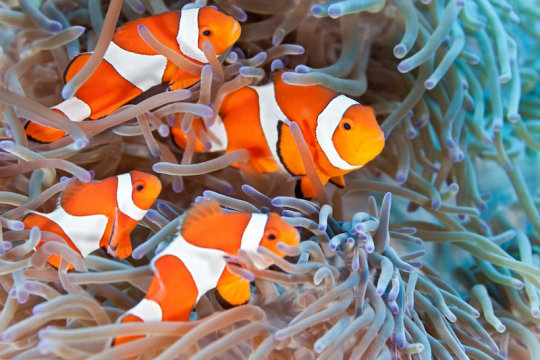[ad_1]
Thanks in part to the popular film Finding Nemo, clownfishes are well known to the public and well represented in scientific literature. But the same can’t be said for the equally colorful sea anemones — venomous, tentacled animals — that protect clownfishes and that the fish nourish and protect in return. A new study published online this month in the journal Molecular Phylogenetics and Evolution takes a step to change that, presenting a new tree of life for clownfish-hosting sea anemones along with some surprises about their taxonomy and origins.
“It’s astounding that when we look at the relationship between clownfishes and sea anemones, which is perhaps one of the most popular examples of symbiosis out there, we have essentially no clue what is going on with one of the two major players,” said Estefanía Rodríguez, one of the co-authors on the new study and an associate curator in the American Museum of Natural History’s Division of Invertebrate Zoology.
The relationship between the anemone and the clownfish is a mutually beneficial one. The fish have the ability to produce a mucus coating that allows them to shelter within the anemone’s venom-filled tentacles without being stung. This protects clownfishes from bigger fishes, like moray eels, which can be stung by the anemone if they get too close. In return, the highly territorial clownfishes will ward away animals that might try to eat the anemone. In addition, their feces serve as an important source of nitrogen for the anemone, and some research suggests that as the fish wiggle through the anemone’s swaying tentacles, they help oxygenate the host, possibly helping it grow.
There are about 30 clownfishes that have this symbiotic relationship with anemones, and they originated in the “coral triangle” of southeast Asia. There are 10 described species of clownfish-hosting anemones, but scientists suspect that the total number may be much higher. And the information on the origin of these species, as well as the number of times the symbiosis evolved in anemones, is sparse and dated. To fill in these gaps, the research team, led by Museum Gerstner Scholar and Lerner Gray Postdoctoral Fellow Benjamin Titus, built a phylogenetic tree based on DNA from newly collected anemone specimens.
They found that as a group, anemones independently evolved the ability to host clownfish three times throughout history. That finding in itself was not unexpected, but the groupings of the species were very different than what previous work had predicted.
Two of the three independent groups originated in the Tethys Sea, an ancient ocean that separated the supercontinent of Laurasia from Gondwana during much of the Mesozoic, and in today’s geography, is located near the Arabian Peninsula. The data are unclear about the origin of the third group.
“For a symbiosis that’s supposedly highly co-evolved, the groups originated in very different parts of the world and probably also at very different times,” Titus said.
The findings suggest that these anemones, at least the ones that originated in the Tethys, are quite old, living at least 12 to 20 million years ago and possibly earlier.
Research on this group is especially relevant as clownfishes — and their anemones — face threats from the aquarium and pet trade.
“These are very heavily collected animals, but we don’t even know how many species exist in this group,” Rodríguez said. “We have a lot of work to do so we can determine what’s there now, what kind of threats they face, and how we can protect them.”
Other authors include Charlotte Benedict, Auburn University; Robert Laroche, University of Houston; Luciana C. Gusmão, Vanessa Van Deusen, and Tommaso Chiodo, American Museum of Natural History; Christopher P. Meyer, National Museum of Natural History; Michael L. Berumen, King Abdullah University of Science and Technology; Aaron Bartholomew, American University of Sharjah; Kensuke Yanagi, Costal Branch of Natural History Museum and Institute, Japan; James D. Reimer, University of the Ryukyus, Japan; Takuma Fujii, Kagoshima University; and Marymegan Daly, The Ohio State University.
This work was supported in part by the Gerstner Scholars Postdoctoral Fellowship and the Gerstner Family Foundation, the Lerner-Gray Fund for Marine Research, and the Richard Gilder Graduate School at the American Museum of Natural History; the National Science Foundation’s (NSF) Research Experience for Undergraduates program (grant # DBI 1358465); NSF 1457581 and DEB 1257630; the Japan Science and Technology Agency and the Japan International Cooperation Agency in cooperation with Palau International Coral Reef Center and Palau Community College (SATREPS P-CoRIE); Japan Society for the Promotion of Science Kakenhi Grants (JP255440221, JP17K15198, JP17H01913); Kagoshima University; King Abdullah University of Science and Technology Office of Competitive Research Funds (CRG-1-2012-BER-002).
[ad_2]















